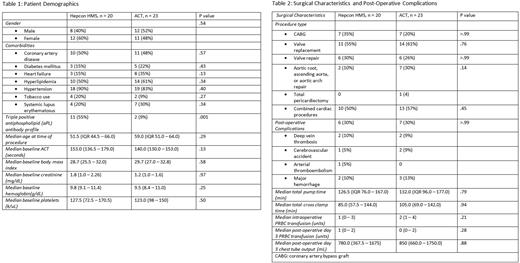Abstract
Introduction: Patients with Antiphospholipid Syndrome (APS) undergoing cardiopulmonary bypass (CPB) surgery are at increased risk for thrombotic and hemorrhagic complications. Heparin concentration during CPB is typically monitored by the activated clotting time (ACT), however, antiphospholipid antibodies have the potential to alter the baseline ACT. The Hepcon Hemostasis Management System (HMS) utilizes an individualized heparin dose-response curve to estimate free plasma heparin levels and has been shown to correlate well with anti-Xa levels. The purpose of this study is to evaluate the efficacy of Hepcon HMS in reducing thrombotic and hemorrhagic complications in APS patients undergoing cardiac surgery requiring CPB in a large cardiac surgery referral center. Herein, we report the largest cohort study to date of APS patients monitored with Hepcon HMS during CPB surgery.
Methods: We performed a retrospective study of APS patients who underwent cardiac surgery requiring CPB at the Cleveland Clinic between April 2013 and July 2020. Two sets of antiphospholipid (APL) antibody labs spaced at least 12 weeks apart, or one set of APL labs in addition to historical elevated antibodies must have been present for inclusion. Vascular thrombosis or pregnancy morbidity (defined by revised Sapporo criteria) must have been documented for inclusion. The Hepcon HMS was utilized for intraoperative (intra-op) anticoagulation monitoring at the discretion of the cardiothoracic surgeon, anesthesiologist, and perfusionist. Data including blood product administration, thromboembolic, and major hemorrhagic complications were collected from the intra-op period through post-operative (post-op) day 30. Major hemorrhage was defined using the International Society on Thrombosis and Haemostasis criteria. The primary endpoint was the composite rate of thromboembolic or hemorrhagic complications per surgical case in patients monitored by Hepcon HMS vs. patients monitored by point-of-care-ACT. Secondary endpoints were median volume of chest tube output and packed red blood cell (PRBC) transfusion within the first 3 post-op days. Continuous and categorical variables were analyzed using Wilcoxon rank sum test and Fisher's exact test, respectively.
Results: Of 201 screened patients, 43 met inclusion criteria. Of the 43 patients, 20 (47%) patients were monitored using Hepcon HMS during CPB surgery while 23 (53%) were monitored using point-of-care ACT. The two groups did not have a statistically significant difference in baseline characteristics including gender, comorbidities, age, and pre-op ACT, body mass index, creatinine, hemoglobin, and platelet count. The presence of triple positive APL antibody profile was statistically significant between the two groups with 11 such patients in the Hepcon HMS group and 2 such patients in the ACT group (p = .001). Surgical characteristics including total pump time, total cross clamp time, procedure type, and intra-op PRBC transfusion were not significantly different between the two groups. For the primary endpoint, there was no statistically significant difference between the Hepcon HMS and ACT groups (Hepcon HMS 6/20 [30%]; ACT 7/23 [30%]; p = >.99). For the secondary endpoints, there was no statistically significant difference in median post-op chest tube output (780mL vs. 850mL; p = .88) and median post-op PRBC transfusion (1 unit vs. 0 unit; p = .28) between the Hepcon HMS and ACT groups, respectively. Subgroup analysis of patients with triple positive APL antibody profile did not show a statistically significant difference in rate of complications between those monitored with Hepcon HMS vs. those monitored by ACT (27% vs. 50%, p = .54).
Conclusion: In this largest to date cohort study of APS patients who underwent CPB surgery, there was no difference in the composite outcome of thrombotic or hemorrhagic complications in patients monitored by Hepcon HMS vs. those monitored by ACT. Both groups had a high rate of complications, which highlights the high-risk nature of this patient population. Prospective randomized trials are warranted to better define optimal heparin concentration monitoring during CPB surgery in APS patients.
Disclosures
No relevant conflicts of interest to declare.
Author notes
Asterisk with author names denotes non-ASH members.


This feature is available to Subscribers Only
Sign In or Create an Account Close Modal